Summary: What exactly is a video codec? Which video codecs stand out as the best options, and how can you determine the most suitable one for tasks like handling 4K content, streaming, or ensuring the utmost video quality? This post has got you covered with everything you need to know about video codecs, including the simplest way to change video codecs effortlessly.
The digital age is here and videos are at its forefront. According to Aberlo, an astounding 92% of internet users worldwide watch digital videos every week in 2024. Not to mention, YouTube highlights that mobile video consumption grows by an impressive 100% every year.
What makes this massive influx of video content possible? The answer lies in the arcane world of video codecs. These technical marvels are the very foundation of seamless video playback, ensuring that our favorite movies, TV shows, and online content can be enjoyed with minimal interruption and maximum quality. But What exactly is a video codec, and which leading option should you choose in 2025?
In this comprehensive guide, we'll first explore what video codecs are, and then delve into the best options currently available, examining their features, performance, and suitability across a wide range of use cases.
This article will guide you through:
What Is a Video Codec
A video codec is a type of software or device that compresses and decompresses digital video.
In essence, it converts the raw, uncompressed data into a smaller, more manageable format that can be easily stored or transmitted and then decompressed for viewing or editing.
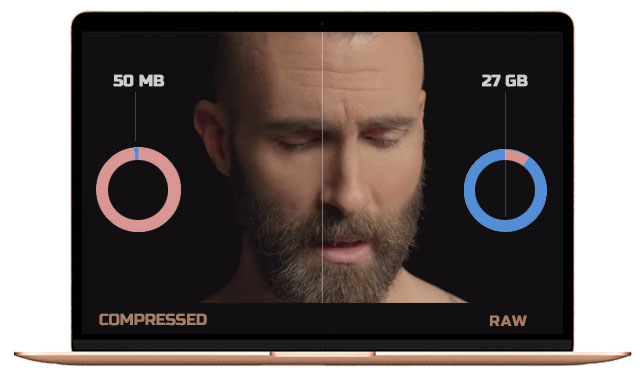
How Modern Video Codecs Work
Video codecs use complex mathematical algorithms and equations to identify and remove redundancies in video data, thereby reducing the video size without compromising much on quality.
What Are Video Redundancies
Generally speaking, the redundant information in the video include:
| Type of Redundancy | Description | Compression Method |
|---|---|---|
Spatial Redundancy |
Similarities in adjacent pixel blocks |
Intra-Predictive, DCT |
Temporal Redundancy |
Similarities between consecutive frames |
Inter-Predictive, Motion Compensation |
Visual Redundancy |
Human insensitivity to certain image details |
Non-linear Quantization Coding, Positional Encoding |
Structural Redundancy |
Repeated textures or patterns in a frame |
Contour Encoding, Region Splitting, and Merging |
Common Video Codec Compression Approach
While different video codecs may use varying mathematical techniques, they generally follow a similar approach to compressing videos. This common approach can be broken down into three main steps:
- Step 1. Prediction (Intra-frame, Inter-frame): Eliminate spatial and temporal redundancy.
- Step 2. DCT Transform and Quantization: Remove visual redundancy.
- Step 3. Entropy Coding: Remove entropy redundancy.
International Standards for Video Codec
Video codecs, crucial for video communication and streaming, are governed by specific international standards. Key players in establishing these have been the ITU and ISO/IEC.
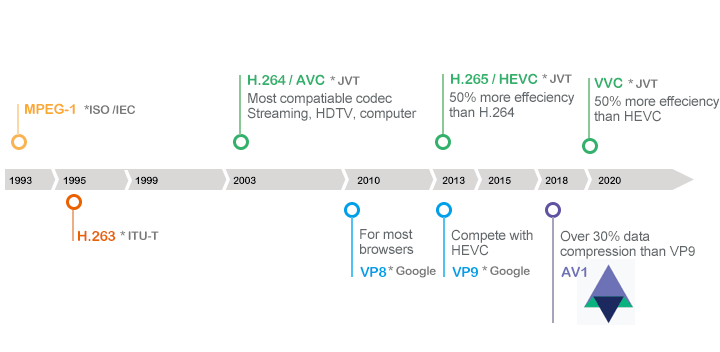
- ITU introduced the H.26X series video codecs that include H.261, H.262, H.263, H.263+, and H.263++.
- ISO/IEC brings the MPEG series, which includes MPEG1, MPEG2, MPEG4, MPEG7, and MPEG21.
- The ITU and ISO/IEC co-formed the Joint Video Team (JVT), which notably developed the H.264 video codec standard.
6 Best Video Codecs in 2025
1. H.264 or AVC
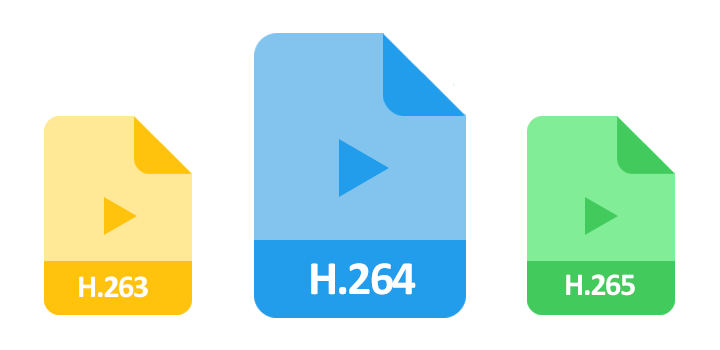
H.264, also known as AVC (Advanced Video Coding) or MPEG-4 Part 10, is the most widely used video codec in today's digital world. Introduced in 2003, H.264 stands out with its remarkable compression efficiency.
For example, compared to H.263 and MPEG-2, H.264 can deliver similar video quality at half the bitrate or less. This helps users to save a lot of storage and bandwidth.
Initially, the complex nature of H.264 posed implementation challenges for most devices and systems. However, as technologies evolved and the demand for better video quality increased, H.264 became the industry standard. As of September 2019, an overwhelming 91% of video industry developers relied on H.264 for recording, compressing, and distributing video content. Most devices built in the last decade, including laptops, desktops, smartphones, tablets, smart TVs, gaming consoles, and more, likely support H.264. In addition, mainstream video-capturing devices such as iPhone cameras, GoPros, DJI drones, and DSLRs can record videos in H.264.
Compatible Systems and Devices:
- Mobile devices: Nearly all iOS and Android smartphones and tablets.
- Gaming consoles: PlayStation 3, 4 and 5; all Xbox Consoles.
- Smart TVs: Samsung, LG, Sony, Panasonic models, etc.
- Computers: Macs, PCs, certain Linux distributions, etc.
- Web Browsers: Google Chrome, Safari, Mozilla Firefox, Microsoft Edge, etc.
Compatible Services and Software:
- Streaming platforms: YouTube Prime, Netflix, Hulu, Amazon Prime, and Disney+, etc.
- Conference platforms: Zoom, Skype, Cisco Webex, MS Teams, and Google Meet, etc.
- Video editing software: Adobe Premiere Pro, Final Cut Pro X, Camtasia, DaVinci Resolve, VideoProc Vlogger, etc.
- Video playback software: VLC Media Player, GOM Player to QuickTime Player, etc.
Pros:
- H.264 encoded videos can play almost everywhere.
- H.264 supports resolution up to 8K UHD.
- H.264 is widely used by streaming Internet sources like HuHu and Netflix.
- H.264 supports most container formats (MP4, MOV, MKV, WebM, etc.).
- 4K H.264 files are limited to 60 fps (frames per second).
Cons:
- Lower compression efficiency compared to newer video codecs like HEVC and AV1.
2. H.265 or HEVC
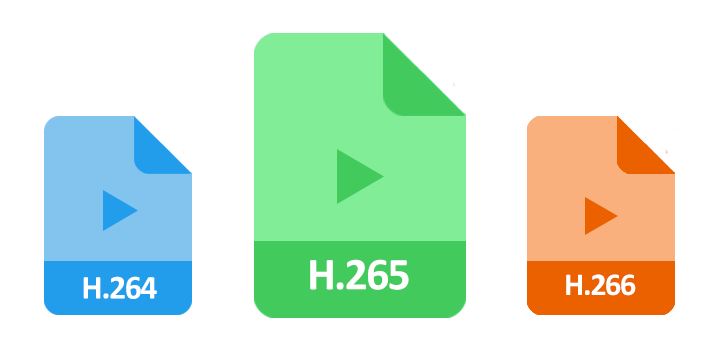
H.265, also known as High-Efficiency Video Coding (HEVC), is faster than its predecessor, H.264. H.265 is particularly effective for compressing high-detail, "cinematic" videos. It can provide better video quality at the same bitrate or the same video quality at a lower bitrate compared to H.264. More specifically, H.265 might deliver video quality nearly identical to H.264 while cutting the file size nearly in half. In more specific terms, H265's average bit reduction is 65% at 4K UHD, 60% at 1080p, 58% at 720p, and 50% at 480p.
Just like H.264, HEVC supports resolutions up to 8192×4320, including 8K UHD. H.264 10-bit usually supports resolutions up to 4K. (There is H.264 10-bit, but it's not common to see and it's not supported by most hardware). But HEVC's higher fidelity Main 10 profile has been incorporated into nearly all supporting hardware. In other words, every device that supports decoding of h265 should support 10-bit. Another thing worthy to note is that HEVC is the default recording video codec for new models of iPhone, iPad, Android, GoPro, and DJI.
Compatible Systems and Devices:
- Operating System: iOS 11 and later (iPhone), Android 5.0 and later, Windows 10 (version 1507 and later), MacOS High Sierra and later. Note: Some Androids lack 10-bit (Main 10 profile) HEVC support. The native support for HEVC is removed from Windows 10, version 1709 due to licensing costs.
- Gaming Consoles: All Xboxes except for Xbox One.
- Smart TVs: LG (models 2014 onwards), Samsung (models 2015 onwards), and Sony (2017 line-up onwards).
Compatible Services and Software:
- Streaming platforms: Amazon Prime, Apple TV+, Netflix, NBC, Paramount, etc.
- Video editing software: Adobe Premiere Pro, DaVinci Resolve, VideoProc Vlogger, etc.
- Video playback software: VLC Media Player, GOM Player QuickTime Player, and more.
- Web Browsers: Current versions of Safari, Edge, Chrome, Opera, and more.
Pros:
- HEVC offers 50% better compression efficiency compared to its H.264.
- Great for displaying high-definition (HD) video.
Cons:
- Some older devices, including those before iPhone iOS 11 with an A9 chip, don't support HEVC.
- Limited software usage due to stringent license requirements.
- Encoding HEVC videos can take longer than expected.
- Encoding HEVC content requires high-end devices due to its substantial hardware demands.
3. H.266 or VVC
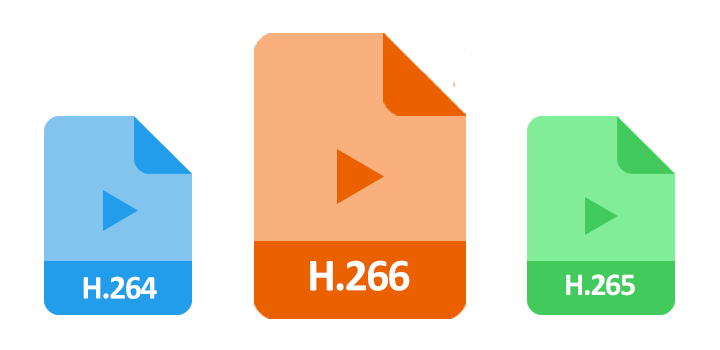
H.266, also known as Versatile Video Coding (VVC), was created as HEVC's successor by the German firm Fraunhofer, whose proposal states that H.266 reduces data requirements by 50% of the bitrate relative to HEVC, leading to video files being transmitted twice as fast. According to research, VVC can offer 27% improvement over HEVC for High-Definition content and 35% for Ultra High-Definition content. The compression techniques are specifically aimed at significantly helping the streaming and playback of 8K videos.
H.266 supports a maximum resolution of 16K and is compatible with 360° and HDR videos. However, the encoding complexity of H.266 is approximately 10 times that of the HEVC (H.265) codec, and the decoding complexity is around 1.5 times higher. This significant increase in computational requirements makes the encoding of H.266 videos a time-consuming and resource-intensive process, which is one of the major reasons why it has not gained widespread popularity compared to the more established H.265 and H.264 codecs.
Compatible Systems and Devices:
- No devices have hardware support for this codec, and only a few software solutions can decode using VVC in real time.
Compatible Broadcast and Software:
- Broadcast: DVB, SBTVD
- Video playback software: Elmedia Player, MX Player, MPC-HC version 2.2.0 or later, and MPC-BE version 1.7.0 or later.
Pros:
- H.266 offers improved compression performance.
- Ideal for streaming high-resolution videos, including 4K, 8K, and 16K.
- H.266 also supports 360° streaming and High Dynamic Range (HDR) video.
Cons:
- H.266 involves a complex encoding and decoding process.
- Slow encoding speed, compared to other video codecs.
- Lack of support by video editing programs and streaming services.
4. VP8
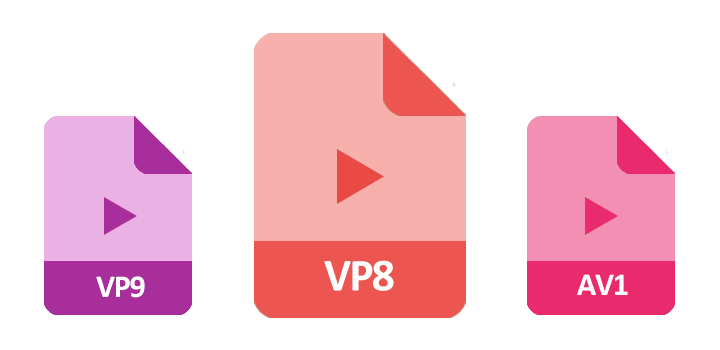
VP8, developed by On2 Technologies and introduced in September 2008, stands as a notable video codec under Google's ownership since 2010. Being royalty-free and distributed under a complimentary license are its primary advantages. Also, various experts continuously contribute to its development. The quality of VP8 is commendable and comparable to the H.264 video codec, thanks to the applicated of several compression techniques like intra-frame prediction, inter-frame prediction, and entropy coding.
Compatible Systems and Devices:
- Operating System: iOS 17.4 and later (iPhone), Android 2.3.3+ and later, Windows 10 (version 1607 and later), MacOS Big Sur, and later.
- Smart TVs: Sony, Sharp, LG, Hisense, and more.
Compatible Services and Software:
- Streaming platforms: Netflix (some of its content), Amazon Prime Video (1080P, 30FPS), and a few other services.
- Video editing software: VideoProc Vlogger, Adobe Premiere Pro, Final Cut Pro, etc.
- Video playback software: VLC Media Player, QuickTime Player, 5KPlayer, and more.
- Web Browsers: all current versions of browsers such as Chroma v32 and later, Edge v18 and later, Safari v16 and later, Firefox v65 and later, and Opera v19 and later.
Pros:
- VP8 is open source and requires no licensing fee.
- As the default video codec in WebRTC, VP8 is highly compatible with most browsers.
Cons:
- Limited hardware support.
- High CPU usage and power consumption.
- VP8 only supports the container formats WebM and MKV.
5. VP9
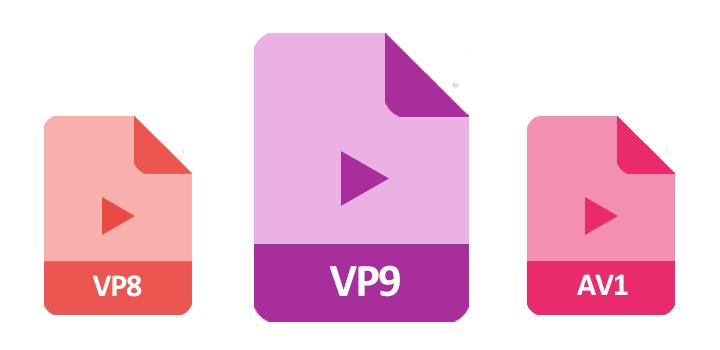
VP9, a video codec that is both open-source and royalty-free, was developed by Google. This successor to VP8 was designed to compete directly with High Efficiency Video Coding (HEVC). YouTube was quick to adopt VP9 after its release in June 2013, and Netflix followed in 2016. VP9 and H.265 have many technical parallels and share the same goal - reducing video file bitrate to enable better streaming of HD and 4K video.
Studies comparing HEVC/VP9 have shown varied results - some argue that HEVC generally outperforms VP9 in compression efficiency, with bitrate savings from 0.6% to 38.2%. Others say VP9 is superior at lower bitrate settings, while H.265 excels at higher bitrates. Regardless, the quality produced by both video codecs is strikingly similar. Where they significantly part ways is in their licensing: VP9 is open-source and free to use, whereas H.265 requires purchasing a license.
Compatible Systems and Devices:
- Operating System: iOS 14.0 and later (iPhone), Android 4.4 and later, Windows 10 (version 1607 and later), MacOS Big Sur and later, and BSD / Linux.
- Gaming Consoles: PSP5 (1080P and 2K), Xbox One X, and Xbox Series X & Xbox Series.
- Smart TVs: the majority of smart TVs were released recently.
Compatible Services and Software:
- Streaming platforms: Amazon Prime, Apple TV+ (4K), Netflix, YouTube Premium, etc.
- Video editing software: Adobe Premiere Pro, DaVinci Resolve, VideoProc Vlogger, etc.
- Video playback software: Windows Media Player and all open-source video players, such as VLC, MPlayer, Kodi, MythTV, and FFplay.
- Web Browsers: Chrome v25 and later, Opera v15 and later, Safari v17 and later (partial support), and Firefox v28 and later.
Pros:
- VP9 is a license-free and open-source video codec.
- VP9 supports all Google products: Chrome, YouTube, and Android.
Cons:
- VP9 does not work on old versions of Apple devices.
- VP9 only supports the container formats WebM and MKV.
6. AV1
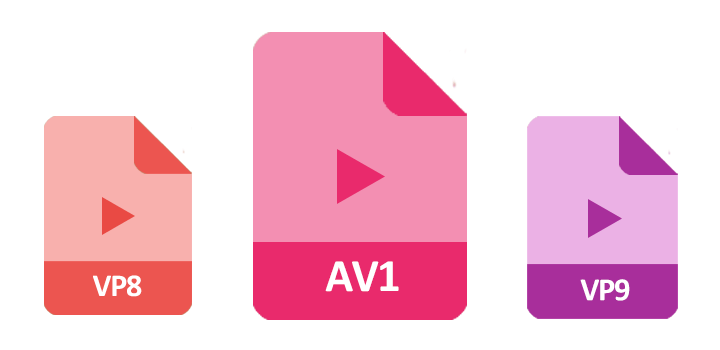
AV1 (AOMedia Video 1), a new video coding format released in 2018, has seen broad acceptance and growing popularity for good reasons. AV1 builds upon the VP9 codec but offers significantly higher compression efficiency. According to tests conducted by BBC R&D, AV1 can achieve the same picture quality as VP9 while saving up to 30% on the required bitrate.
The open-source nature of AV1, free from licensing fees or restrictions, has also been a key factor in its growing acceptance. Combined with the strong institutional backing from tech leaders (Google, Apple, Amazon, Netflix, and Microsoft, etc.) in the Alliance for Open Media, AV1 is poised to become a dominant standard in the video encoding landscape.
Compatible Systems and Devices:
- Operating System: iPhone 15 and later running iOS 16 or later, Android 10 and later, MacOS Sonoma (with hardware decoding support) and later, ChromeOS 70 and later, and BSD / Linux.
- Smart TVs: Amazon Fire TV Stick 4K Max, Roku Streaming Stick 4K, and other recent Roku, Sony, and Samsung models, and more.
- Game Consoles: PSP4 Pro and Xbox One.
Compatible Services and Software:
- Streaming platforms: Amazon Prime, Apple TV+ (4K), Netflix, YouTube Premium, etc.
- Video editing software: Adobe Premiere Pro, DaVinci Resolve, VideoProc Vlogger, etc.
- Video playback software: Windows Media Player, VLC, 5Kplayer, QuickTime Player (on the device with M3 chip), and more.
- Web Browsers: Chrome v70 and later, Edge 121 and later, Opera v57 and later, Safari v17 and later (partial support), and Firefox v67 and later.
Pros:
- AV1 is open-source and royalty-free.
- AV1 equals H.264/AVC's quality but uses ~50% less data.
- AV1 has good software support.
- YouTube and Netflix use AV1 for most 1080P and 4K content.
Cons:
- AV1 has limited hardware support.
Other Video Codecs That Are Worth Considering
We just listed 6 of the most popular video codecs. All of them can heavily compress your video files using complex encoding algorithms. However, the downside is that decoding such highly compressed files can be challenging. Although most video editing software supports these video codecs, they tend to consume a significant amount of computing resources and may cause issues like stuttering, lag, and overheating. Therefore, these codecs are more suitable for delivery rather than editing.
If your primary focus is video editing, it is advisable to consider visually lossless codecs like ProRes, Avid DNxHD, or GoPro Cinform. These video codecs are less compressed, making it easier for video post-production software to decode and re-encode, even on less powerful hardware. However, the trade-off is that these video codecs result in larger file sizes. For example, the bitrate of a video encoded with ProRes 444 XQ is around 500 Mb/s, whereas a video encoded with ProRes 422 is typically around 147 Mb/s.
Additionally, there are several lossless video codecs available, such as H.264 Lossless, H.265 Lossless, Motion JPEG Lossless, and Apple Animation Quicktime RLE. When using lossless compression, none of the original file information is lost, making it ideal for users who need an exact 1:1 copy of their video files. However, lossless video codecs result in larger file sizes, which may not be suitable for online sharing and streaming.
Factors to Consider When Choosing the Best Video Codec
Choosing the right video codec isn't just about picking one randomly and hoping for the best. It requires thoughtful consideration across several factors:
1. Compatibility
A crucial aspect of video codec selection is whether the chosen video codec is compatible with the desired devices and platforms where the video will be watched. Some video codecs are universally supported, while others might only work on specific devices or operating systems.
| Codec Compatibility | Browser | Computer | Mobile | Smart TV/OTT |
|---|---|---|---|---|
H.264 |
97.97% |
All |
All |
All |
H.265 |
20.35% |
Windows, Mac |
Android, iOS |
All |
VVC |
Unknown |
Unknown |
Unknown |
Unknown |
VP8 |
96.35% |
Windows, Mac, BSD / Linux |
Android, iOS |
Most |
VP9 |
82.96% |
Windows, Mac, BSD / Linux |
Android, iOS |
Most |
AV1 |
78.56% |
Windows, Mac, BSD / Linux, ChromeOS |
Android |
Recent models |
2. Bandwidth Requirements
Video codec choice significantly affects the size of your video files and their transmission speed over the internet. If your audience is often on slower networks, a video codec that offers better compression rates could be beneficial.
3. Encoding Time
A notable concern with the implementation of newer video codecs is their increased complexity, which could potentially send encoding costs through the roof. As such, it's crucial to factor in the duration of the video encoding process. Time-efficient encoding doesn't just save you crucial minutes or hours in the production pipeline, but might also have a significant impact on budgeting and overall resource allocation.
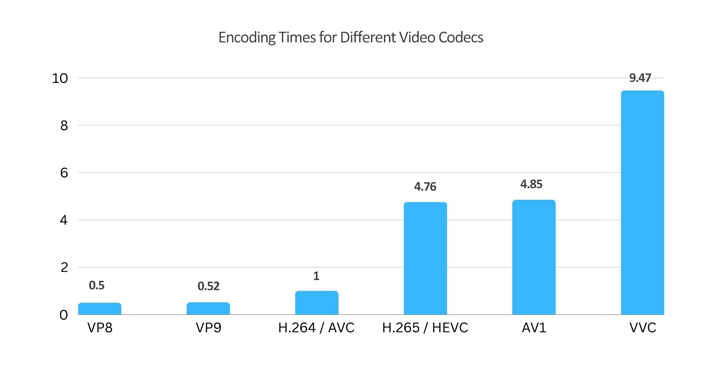
4. Licensing and Cost Implications
Proprietary codecs might come with licensing fees, so consider this when preparing your budget. Choosing an open-source option could save you money.
| Patent | Free |
|---|---|
H.264 / AVC |
VP8 |
H.265 / HEVC |
VP9 |
H.266 / VVC |
AV1 |
5. Future-Proofing
The world of tech is always evolving, so pick a video codec that is likely to remain supported and relevant for the foreseeable future.
How to Convert Video Codecs
Changing the video codec might be necessary for several reasons. You might need a video to be in a specific format for playback on certain devices, or you might want to reduce the file size for easier sharing or storage. Sometimes, you might need to switch to a codec that's compatible with a particular video editing software. Luckily, you can easily achieve this by using VideoProc Converter AI – a beginner-friendly yet powerful video converter that enables you to convert video from 370+ codec and format types to 420+ others quickly while not causing perceivable quality loss.
📌 Key Features of VideoProc Converter AI
- Convert AV1, H.264, HEVC, VP9, VP8, ProRes, Divx, and 370+ file types.
- Support (10bit) HDR, 4K/8K, 60FPS/120FPS/240FPS, and high bitrate videos.
- Up to 47x faster speed, boosted by the level-3 GPU acceleration tech.
- Output profiles for popular devices and platforms like iPhone and YouTube.
- Rich extra tools to compress, record, and download video and audio files.
- New! AI media enhancement: Super Resolution, Frame Interpolation, Image AI...
Now download VideoProc Converter AI to start to change video codec in a few clicks! HOT
Step 1. Import Video File(s)
Lanuch VideoProc Converter AI. Select Video Converter on its main interface. Hit +Video to select the original video files for loading to this best video converter.
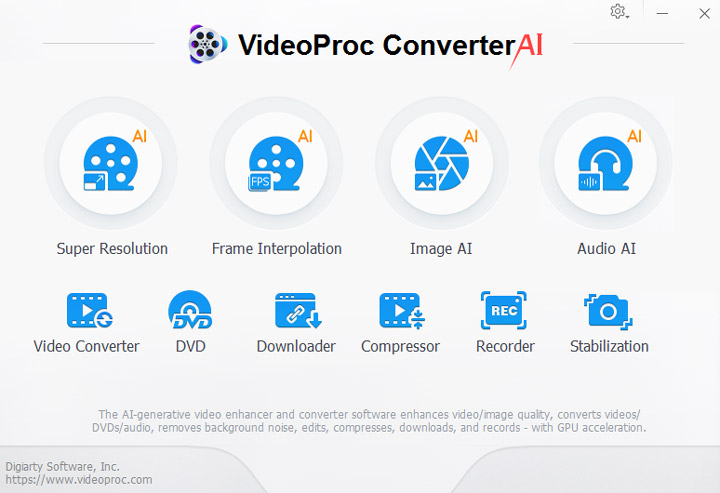
Step 2. Choose the Target Video Codec
Go to the bottom to find and click Video. Choose the output format with the target video codec. You can also click Target Format to find more video codec options.
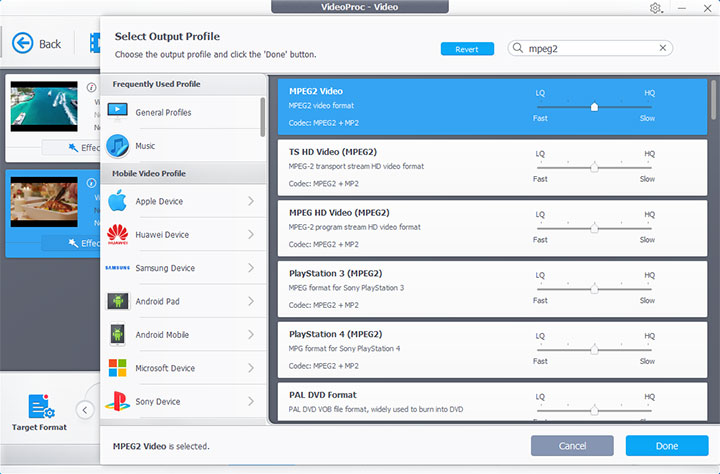
A tip: Click the gear icon to open the Video Codec option, and you can adjust the video frame rate, resolution, profile level, GOP length, and more encoding settings if necessary.
Step 3. Start the Conversion
Check the option box under Hardware Acceleration Engine and check Use High Quality Engine. Hit RUN to start converting the video codec from one to another.
FAQs
What is the highest-quality video codec?
The highest-quality video codec currently available is H.266/VVC (Versatile Video Coding). It has superior compression efficiency compared to its predecessor H.265/HEVC, delivering approximately 50% better compression rates while maintaining the same perceptual video quality. Based on a visual quality test conducted by Chipsandcheese using Netflix's Emmy-winning Video Multimethod Assessment Fusion (VMAF), H.266/VVC has been found to deliver better overall quality for 4K resolution videos at the same given bitrates compared to both H.265/HEVC and the open-source AV1 codec.
What is the best codec for 4K?
The best codec for 4K video depends on your specific needs and use case. H.264/AVC and H.265/HEVC are widely supported and provide good compression efficiency, making them suitable for 4K streaming and general consumer use. VP9 is another great codec for 4K, especially on Google's platforms. For professional 4K video production and post-processing workflows, lossless or visually lossless codecs like ProRes and Cineform are better options. Newer codecs like H.266/VVC and AV1 offer improved compression efficiency over older standards which are future-proof.
What is the most universal video codec?
The most universal video codec is H.264, which has ubiquitous support across devices, platforms, and streaming services, along with hardware acceleration and favorable licensing terms.









